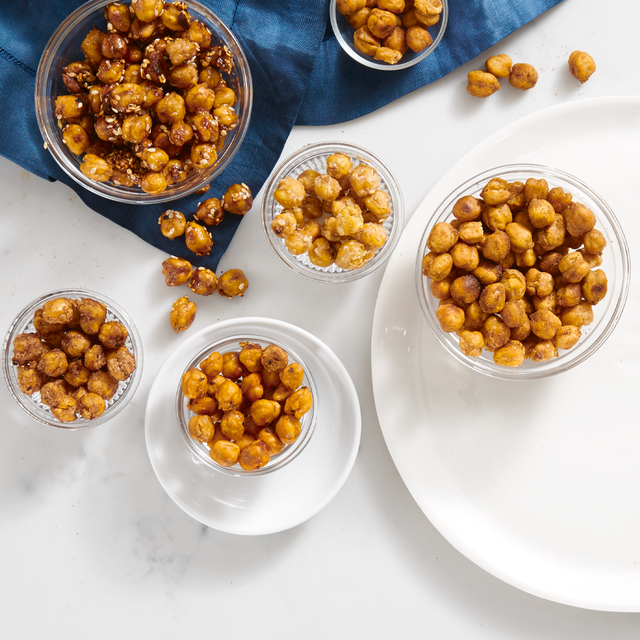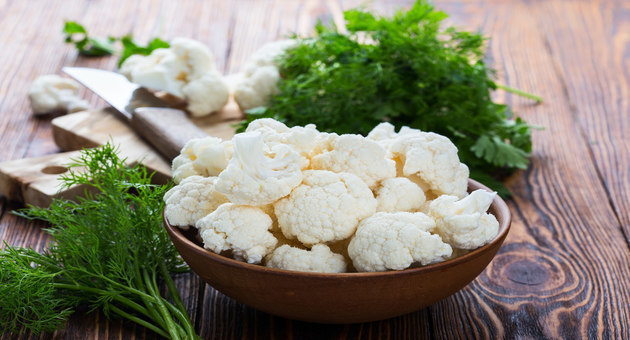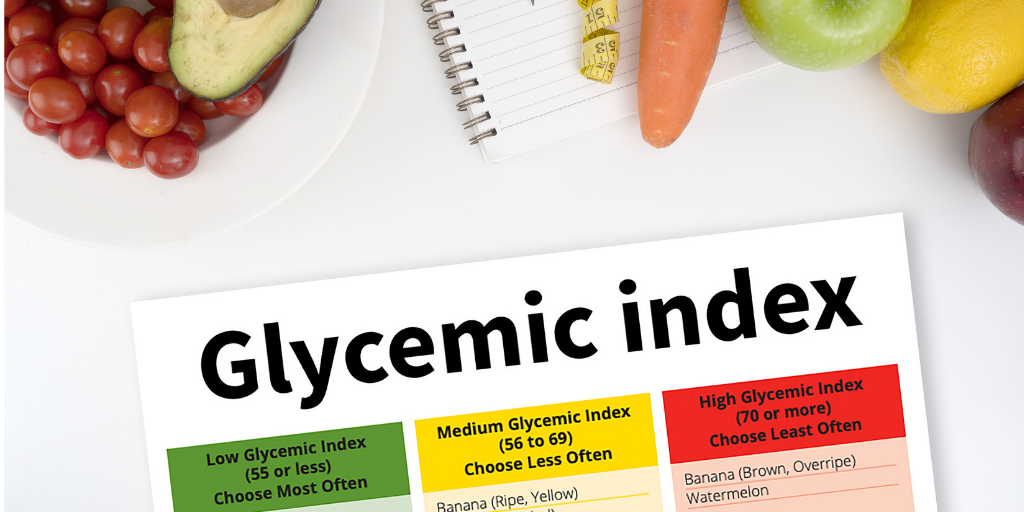Whether you want to lose weight, burn fat, or build muscle, protein is your diet’s essential building block. Fill up on powerful protein with these tasty options.
Snacking on Foods High in Protein Helps Keep You Feeling Full Longer

Hero Images/Corbis
When it comes to healthy eating, there’s a lot of focus on what you shouldn’t be eating. Skip the “added sugars,” “bad fats,” and “bad carbs.” But, what should you be eating? And when you realize your last meal was a bit too light — and your next meal is still a ways off — which snacks are smart choices?
Foods high in protein are good snacking picks because the macronutrient helps keep you feeling fuller longer, explains Mary Wirtz, RDN, a wellness dietitian at the Healthy Living Program at the Mayo Clinic: “Protein takes longer to digest than carbohydrates, so it therefore keeps us satisfied and satiated.”
And the longer you feel satisfied and satiated, the less likely you’ll want to reach for other less-healthy snacks or extra calories, she adds.
Several epidemiological studies that have followed large groups of people over the course of several years have indeed found improved health outcomes in people who eat diets high in protein. Some of those health benefits include lower risk of hypertension, heart disease, and stroke.
Other research suggests diets high in protein can help with weight loss and maintaining a healthy weight. A study published in May 2015 in the International Journal of Obesity, which followed 932 obese families, found that a high-protein diet helped control blood pressure and inflammation in both kids and adults — and helped both the kids and adults in the study lose weight and keep it off.
Why is protein so important? Protein is used by every cell in the body (including our muscles, bones, blood, cartilage, and all tissues) for basic functioning, Wirtz says. Once digested and transported to where we need it, the protein we eat helps our bodies do just about everything we do, from repairing and rebuilding muscle after we exercise to making the hormones and chemicals that help keep our organs functioning and regulate our sleep, digestion, and immune function.
So when we get hungry between meals, high-protein snacks may provide the energy our bodies need (calming our hunger signals) and keep our systems functioning optimally.
It’s important to remember, however, that just because a food is high in protein, that doesn’t mean you should overdo it. Some foods that pack a lot of punch when it comes to grams of protein per calorie, like red meat or full-fat cheese, can also serve up a lot of saturated fat, which should be eaten in moderation.
Here are eight good-for-you snacks that deliver when it comes to protein.
Hard-Boiled Eggs Are Low in Calories and High in Protein

Brent Hofacker/iStock.com
For years, eggs got a bad rap because of their high cholesterol content. But that thinking has changed with newer evidence suggesting it’s the saturated and trans fats in our diets that are worse for our blood cholesterol levels than the amount of cholesterol in the food we eat.
One whole, large egg has just 1.6 grams (g) of saturated fat, plus 6 g of protein and only 78 calories. The bottom line: The benefits of including eggs in your diet outweigh the cholesterol risks if you limit how many you eat to one whole egg per day (though people with diabetes should limit their intake to three total per week).
One of the simplest ways to enjoy eggs as a snack is to eat them hard-boiled. Keep a bowl of them in your fridge for an instant healthy snack that’s easy to take with you.
Nuts Have Protein, Plus Good-for-You Fats

iStockphoto.com
Whether you’re a fan of almonds, cashews, walnuts, or pistachios, whole nuts are a healthy high-protein snack choice. Plus, nuts are high in fiber, which when paired with protein keeps you feeling full longer, too (since fiber requires more chewing time, it affects satiety hormones, and it doesn’t get broken down by the body the way other macronutrients do). While nuts are chock-full of heart-healthy fats, it’s still important to measure out portions, as they’re a calorie-dense food. Be sure to stick to one ounce — about a handful.
If you’re stumped in the nut aisle, almonds, which offer up 6 g of protein and 3.5 g of fiber per serving (about 23 nuts), are a tasty place to start. A study published in the January 2015 issue of the Journal of the American Heart Association found that eating almonds daily, in place of a high-carbohydrate snack, lowered harmful LDL cholesterol and reduced abdominal fat in those with high LDL cholesterol.
Greek Yogurt Is Thick, Creamy, and Full of Protein

iStockphoto.com
In just a few years, Greek yogurt has gone from newcomer on the superfood scene to supermarket staple. Strained to remove the whey, Greek yogurt is thicker and creamier than regular yogurt, making it a satisfying snack option — and it’s higher in protein than regular yogurt.
Enjoy plain fat-free or 1 percent fat Greek yogurt as a base for fresh fruit, cereal, or nuts. Or opt for a flavored variety for a quick grab-and-go snack (just be sure to read the label to make sure you’re not choosing a variety that’s too high in sugar). Greek yogurt packs a protein punch with 15 to 20 g in a 6-ounce serving (versus approximately 7 to 9 g per serving of regular yogurt).
Banana Sushi Squelches Hunger and Tastes Great

Get fancy with your favorite nutty spread and whip up this fun banana sushi recipe from Fit Foodie Finds. Spread 2 tablespoons of peanut butter across the top of a banana, then sprinkle with a tablespoon of chia seeds and some crushed pistachios before slicing into 14 rounds. Store them in the freezer for a frozen snack you can pop in your mouth when hunger hits. Seven “sushi” bites deliver 5 g of protein for fewer than 200 calories.
Cottage Cheese Is Heavy on Protein, but Light on Calories

Getty Images
Low-fat cottage cheese has long been a staple on the grocery list of the health-conscious, and for good reason: It’s an excellent source of protein, with 14 g of protein per half-cup, and has less than 100 calories per serving. Paired with diced fruit, veggies for dipping, or on its own, it makes a terrific snack that will hold you over between meals.
Black Bean Dip: The Protein Pick That Will Cure Your Craving for Something Salty, Too

Getty Images
Beans are an easy go-to when you need a protein boost, and when mashed or blended they make a snack-worthy dip. Black beans are a tasty option with almost 8 g of protein per ½ cup; or opt for cannellini beans with 7 g per ½ cup. Simply combine drained and rinsed beans, chopped onion, minced garlic, chopped cilantro, lime juice, and your favorite seasonings in a blender. When the munchies hit, enjoy ½ cup with veggie stick dippers for a filling snack.
Celery and Nut Butter Is Not Just for Kids

Lauri Patterson/Getty Images
This savory veggie-nut combo is also a fiber-and-protein win. While peanut butter is a tried-and-true favorite (add raisins for the classic ants on a log), a slew of other nut butters are available, including almond and sunflower butters.
Nut butters are high-protein foods, with two tablespoons providing about 7 g of protein. And though nut butter does contain fat, it can be a healthy addition to your diet when eaten in moderation (since the fats are the good-for-you unsaturated types). Enjoy the spreads on celery (or carrots or other veggies) to help keep calories in check.
Edamame: The High-Protein Snack Made for Mindful Eating

iStockphoto.com
Half a cup of edamame, or fresh soybeans, contains 8 g of protein, making for a satisfying 100-calorie snack. Try them in the pod sprinkled with a touch of sea salt. Pinch the beans from the pods as you go, which helps slow down your eating, giving your brain time to register that you’re full — you’ll ultimately eat less.


